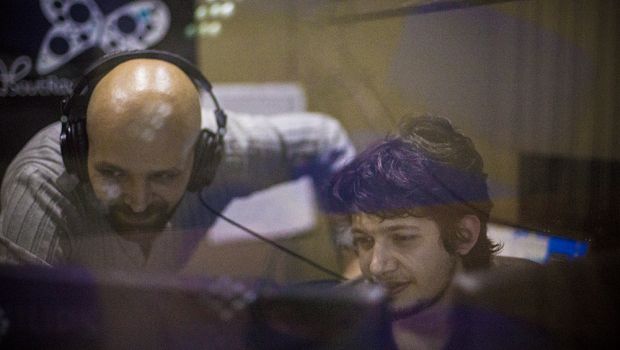Five years ago, Syrian radio host Mahmoud Hassino came across the journal of a doctor from Hama. What he read there inspired him to provide his listeners with something revolutionary.
The journal was written in 1982 during the Muslim Brotherhood uprising in Hama and the subsequent bloody crackdown by Hafez Al-Assad’s forces. Between 10,000 and 40,000 people are believed to have died during the military siege. The doctor described how he had turned on the radio during the quieter days and searched for reports about what was happening on the BBC World Service and other medium-wave channels.
“He kept looking, but he didn’t find anything,” says Hassino. “He felt like he didn’t exist. And that was the first thing I thought of when I started working here. I think that sometimes people might turn on their phone or radio and listen to us, and realize that people are thinking of them, without being part of any political game.”
Hassino works for Sout Raya, an independent radio station founded and run by Syrians, broadcasting news, music, comedy, drama and political debate from its Istanbul studio to audiences inside Syria. Hassino’s weekly show, “Souriya B’oyonoun” (Syria Through Their Eyes), is a political discussion program that analyses perspectives from both sides of the Syrian conflict. “In my program I criticize everybody,” he says. “For an Arab audience, this is a really new thing.”
The station is one of around a dozen that have been set up in and around Syria since the start of the revolution. One of the lesser-reported trends in the conflict is the explosion of new media outlets in the opposition-held areas—all of them free from the stifling control of the Ba’ath Party, which has dominated and censored the media for more than fifty years.
But Hassino says that Sout Raya is aiming to be something different: a truly impartial news source that gives Syrians an objective take on what is happening inside their country.
“This is a media war, of course,” he says. “The rebel groups have their own military propaganda newsletters, and all the TV stations are just trying to prove that they are pro-revolution. Actually, the only thing you should need to prove is that you are pro-the people.”
But that is no easy task in a conflict that is riddled with slogans, propaganda and bias. The new channels may be breaking the mold by criticizing the regime, but Hassino believes they are still following the old Ba’athist model: biased, but in the other direction. “Even the Syrian National Coalition, their press releases use Ba’athist language. They always end with their slogan: ‘Long live Syria and its people, free and with honor,’” he says. “We’ve had this regime for more than fifty years, so it’s the only way people know how to deal with politics.”
At Sout Raya, language has become the building block of impartiality. The team has created a strict set of guidelines for reporting on the conflict in Syria. The terms that are commonplace on the opposition media channels—such as “revolution,” “martyrs” and “Bashar’s gangs”—are out. Instead, the presenters talk about “the regime” and “the opposition,” and refer to the situation in Syria as “the crisis.” In another break with the traditions of Arab media, most of the programs are broadcast in the Syrian dialect rather than in formal Arabic. “It is closer to the people; they understand more,” Hassino explains.
But impartial broadcasting in a war zone is a complex and often fraught endeavor. The station’s on-the-ground reporters have to work anonymously in both regime and opposition areas because of fears for their safety. In November 2013, the station’s transmitter in Latakia governorate was stolen, limiting the station to online broadcasting.
Hassino explains that the station’s non-critical style has often made it difficult to persuade guests to appear on the program. Yet even in the Internet age, Hassino is adamant that the radio is still the best way to reach people who are trapped by conflict and dictatorship.
Sout Raya’s style is new and revolutionary in itself, but, like any revolution, it will take time to blossom. “It’s tricky, because Syrians expect the media to be on one side or the other,” says Hassino. “They don’t expect that media can be free. But we need real and objective media. I believe that revolution is about changing the whole vision of life.”
This article was originally published in The Majalla.
All views expressed in this blog post are those of the author and do not necessarily represent the views of, and should not be attributed to, The Majalla magazine or Asharq Al-Awsat newspaper.

